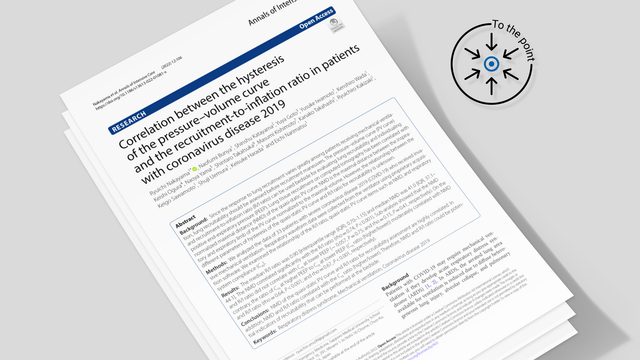
Author: Marcela Rodriguez Jimenez
Date of first publication: 06.02.2024
Last change: 04.04.2024
Removal of linked article on assessing recruitability ‑ no new revision要点:準静的PV曲線上の正規化最大距離とリクルートメント対拡張比は、ベッドサイドで使用できる肺リクルータビリティの有望なインジケータである。

臨床的論点
人工呼吸を受けているCOVID‑19患者において、低流量の準静的プレッシャー/ボリューム(PV)曲線に基づく肺リクルータビリティ評価とリクルートメント対拡張(R/I)比の間にどのような関係があるのか?
臨床的背景
- 肺リクルータビリティとPEEPタイトレーションの理論的利点にもかかわらず、ARDS患者におけるそれらの使用と最適な人工呼吸器設定については依然として議論が続いている。これらの戦略は、PaO2/FiO2比(P/F比)が200 mmHg以下である中等度から重度のARDS患者において特に意義がある。
- 肺リクルートメントに対する反応は患者によって大きく異なるため、肺リクルートメント手技(LRM)を実施する前に肺リクルータビリティを評価する必要がある。
- ベッドサイドで肺リクルータビリティを評価し、個々の患者に合わせたPEEPを決定するには、プレッシャー/ボリューム曲線(PV曲線)とリクルートメント対拡張比(R/I比)を使用できる。
- PV曲線のヒステリシスパラメータはCT上の肺組織リクルートメントと相関関係があることが示されているが、R/I比とCT評価の相関関係はまだ検証されたことがない。
デザインおよび環境
- 後ろ向き、単施設コホート研究(
Nakayama R, Bunya N, Katayama S, et al. Correlation between the hysteresis of the pressure‑volume curve and the recruitment‑to‑inflation ratio in patients with coronavirus disease 2019. Ann Intensive Care. 2022;12(1):106. Published 2022 Nov 12. doi:10.1186/s13613‑022‑01081‑x1 ) - 2021年1月1日~2021年9月30日の期間に札幌医科大学医学部救急医学講座高度救命救急センターの集中治療室で侵襲的人工呼吸を受けていたCOVID‑19患者
患者
- COVID‑19の診断を受けている
- HAMILTON‑C6人工呼吸器による侵襲的人工呼吸で治療されている
- 非侵襲的酸素療法で93%のSpO2を維持できない(その後、日本のCOVID‑19治療ガイドラインに従って人工呼吸器を開始した)
| 選択基準 | 除外基準 |
| 18歳以上 | 18歳未満 |
| 鼻スワブのポリメラーゼ連鎖反応または定量的抗原検査によるCOVID‑19の確定診断 | Datalogger 5.00による呼吸データの記録なし |
| Datalogger 5.00を使用した準静的PV曲線とR/I比の同時評価 | |
介入 | ||
| 準静的PV曲線 | R/I比(リクルートメント対拡張比) | リクルータビリティ評価 |
|
|
|
測定と主な結果 | ||
| 登録およびベースライン特性 | NMDとR/I比の相関関係 | コンプライアンスとリクルータビリティ項目の関係 |
|
|
|
主要アウトカム
- NMDとR/I比の相関関係は、20 cmH2O時の距離のような他のパラメータとR/I比の相関関係よりも有意に高かった。
- NMDとR/I比はどちらも、Crsに対する相関関係を示さなかった。その代わりに、Crs比(高レベル/低レベル)に対する相関関係を示した。
- 上記の結果は、NMDとR/I比が他の肺リクルータビリティ評価パラメータよりも有益である可能性があることを示す。
結論
リクルータビリティ評価において、準静的PV曲線のNMDとR/I比の間には強い相関関係がある。さらに、NMDとR/I比はCrs比(高レベル/低レベル)とも相関する。したがって、NMDとR/I比は、ベッドサイドで実施できるリクルータビリティのインジケータとして有望な可能性がある。
制限
- 本研究はサンプルサイズが比較的少ないため、その結果のより広範な集団に対する一般化可能性は限られている可能性がある。
- 本研究の単施設、後ろ向きデザインはバイアスを持ち込む可能性があり、結果の一般化可能性を限定する可能性もある。
- 著者らは肺リクルータビリティを評価するためのCTデータが欠如していたことを認めており、そのようなデータがあれば、それを基により確実な結果の妥当性検証ができた可能性がある。
- 本研究はARDSの不均一性を強調しており、これはリクルータビリティのインジケータとしてのコンプライアンスの一貫性に影響を与える可能性がある。
- 本研究では以前の研究と異なる方法が用いられており(以前の研究では、PV曲線の下変曲点としてAOPが特定され、2分以上経過後にプラトー圧が測定された)、これは結果のばらつきにつながる可能性がある。
Hamilton Medicalの技術を使用してこれらの結果を日々の臨床業務に取り入れる方法
- ARDS患者のPEEPまたはLRMに対する反応は、各個人の肺のリクルータビリティに依存し、したがって患者ごとに大きく異なるため、予測することは難しい。PEEPの増加またはLRMの実施は、特にリクルータビリティが低い患者では有害となる可能性がある。過度に高いPEEPは肺の過膨張を引き起こし、その結果左右の心機能障害が生じる可能性がある。
- PV曲線上の最大距離時の気道内圧が20 cmH2O未満の患者においてNMDとR/I比の間に強い相関関係があることは、NMDがPEEPの安全範囲内での肺リクルータビリティの有益なマーカーであることを示唆する。これを理解しておくと、医療専門家はより多くの情報を基に個々の患者のPEEP設定を決定することができ、最適な肺リクルートメントの確保と過膨張リスクの軽減につながる。
- Hamilton Medical人工呼吸器のP/V Tool技術を使用して取得したNMDは、以前にあるCTスキャン研究で検証されている(
Chiumello D, Arnal JM, Umbrello M, et al. Hysteresis and Lung Recruitment in Acute Respiratory Distress Syndrome Patients: A CT Scan Study [published correction appears in Crit Care Med. 2022 Mar 1;50(3):e339]. Critical Care Medicine. 2020;48(10):1494‑1502. doi:10.1097/CCM.00000000000045182 )。それに対してR/I比は、まだCTスキャンやヒステリシスなどの参照法と直接的に比較検証されたことはない。 - エビデンスは、P/V Toolは肺リクルートメントの測定手段として適応性と信頼性が高く効果的であることを示している。現在の換気モードを変更する必要がないため、臨床実践にスムーズに組み込むことができる。
リソース
Hamilton Medicalは、P/V Toolを使用したリクルータビリティの評価、リクルートメント手技の実施、PEEPの設定について説明する教材を幅広く提供しています。記事、動画、Eラーニングモジュールなどにアクセスするには、以下のリンクをクリックしてください。
Footnotes
References
- 1. Nakayama R, Bunya N, Katayama S, et al. Correlation between the hysteresis of the pressure‑volume curve and the recruitment‑to‑inflation ratio in patients with coronavirus disease 2019. Ann Intensive Care. 2022;12(1):106. Published 2022 Nov 12. doi:10.1186/s13613‑022‑01081‑x
- 2. Chiumello D, Arnal JM, Umbrello M, et al. Hysteresis and Lung Recruitment in Acute Respiratory Distress Syndrome Patients: A CT Scan Study [published correction appears in Crit Care Med. 2022 Mar 1;50(3):e339]. Crit Care Med. 2020;48(10):1494‑1502. doi:10.1097/CCM.0000000000004518


